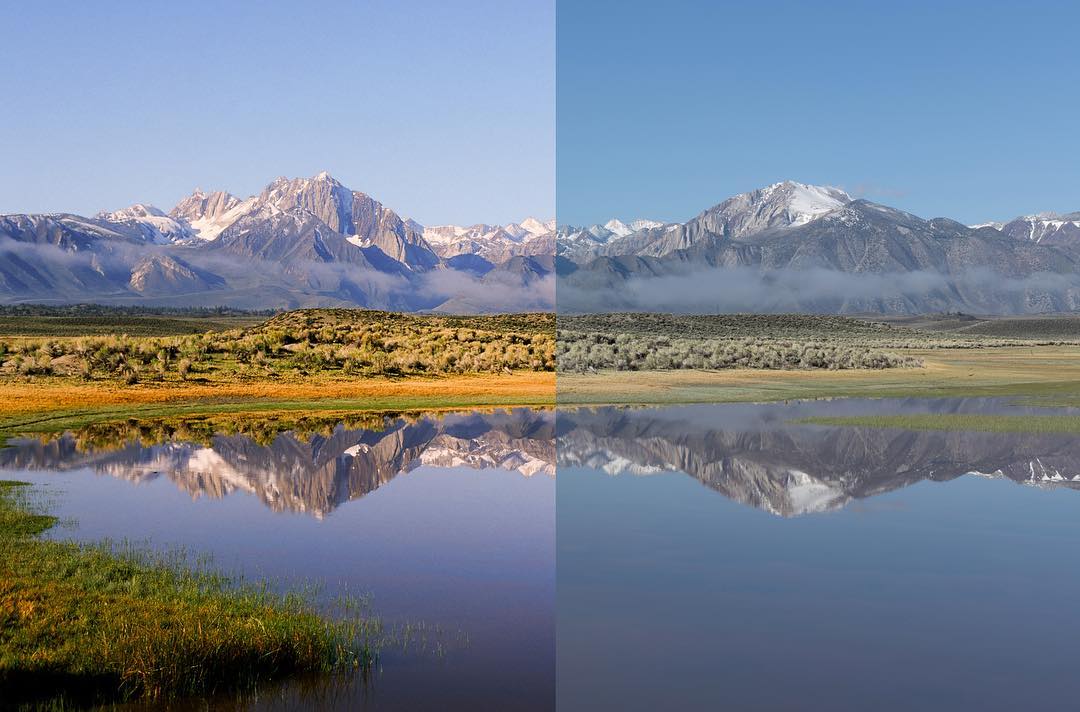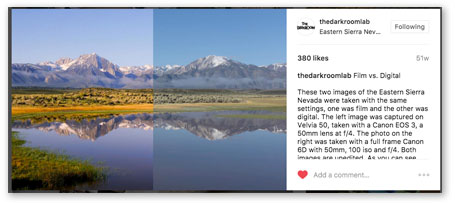What Makes One Film Camera Better Than Another
With film usage and adoption on the ascent, nosotros wanted to resurrect the debate of digital photos versus analog photos. Equally a movie processing lab, nosotros obviously have a bias, so not going to say which is better, but to present the differences and list advantages.
While in Eastern Sierra Nevada, we shot ii photos, 1 film and the other digital. Both the digital photo and the film photo were taken with the same settings. The left prototype was captured on Velvia l, taken with a Canon EOS 3, a 50mm lens at f/4. The photo on the right was taken with a full-frame Canon 6D with 50mm, 100 iso, and f/4. Both images are unedited. As you tin can encounter, Velvia l has a very fine grain and has rich, vibrant colors straight from the scan compared to the unedited JPEG from the Canon 6D. And yeah, yous practice have the choice to edit digital photos, just there's something special virtually making a beautiful image in-camera on pic and non having to spend any time editing!
As well, if you're looking for a little less saturation, there are other great film choices, like Provia 100, which isn't equally saturated but still has great colour and fine grain, or you could go with a colour negative moving-picture show which will give you more subtle colors and has a wider range of exposure breadth.

Flick Photography Advantages
- Lower initial cost than for a comparable digital camera
- With a higher dynamic range, picture is better at capturing white's and blacks' details and can't be replicated with digital cameras. As well, film can capture subtle details lost in digital photography.
- Film is more forgiving of minor focusing issues and exposure bug.
- Film captures photos at higher resolution than near digital cameras.
- Analog pic can exist pushed or pulled multiple stops when needed, but the corporeality of contrast inside the image is afflicted. Some photographers use this to their advantage to create the platonic wait they want, but this method still does non allow extremely high ISO speeds without impacting image tones.
- Film photographers with a express number of exposures available on a roll of motion picture must think more almost their images before shooting them. Digital photographers tend to take pictures starting time and call up afterwards. Depending on your viewpoint, this is either an advantage or disadvantage.
- Unlike digital cameras, film cameras are time to come proof and don't go obsolete.
- No power or batteries needed. Long trips and common cold conditions tin be limiting for digital cameras.
- The Darkroom photo lab scans your picture photos, now assuasive you to edit your images on a computer with photograph-editing software or share on social media.
Digital Photography Advantages
- The resolution in even point-and-shoot cameras, which is often 12 to 20 megapixels, is loftier plenty resolution for large prints.
- Digital cameras likewise have the advantage of existence able to change motion-picture show speeds between individual photographs.
- The cameras are by and large lighter weight than film cameras.
- Memory cards are tiny and can store many images.
- Instant gratification and images tin can be viewed immediately. Some motion-picture show photographers consider this a disadvantage.
- You can edit your images directly on the photographic camera.
- You can choose to print only the images you like all-time.
- Many cameras offer born filters.
Film Offers Color Consistency and Dynamic Range over Digital
Moving-picture show is the golden standard of photography. Nothing compares – non even digital. A good example of this is when a film company similar Fujifilm tries to match film's cute color consistency. Such an 'advancement' in technology is zero more a marketing gimmick.
Moving-picture show is the gilt standard of photography.
Take Provia and Velvia, for instance; when Fujifilm tried to replicate these stunning motion picture stocks into their mirrorless digital cameras, it was a lamentable day indeed. Rather than making more than film, they halted product and turned their attention to replicating the color science in photographic camera. Digital mirrorless owners rejoiced as they could now take photos enriched with 'Veliva' and 'Provia' simulations. Looking at these cameras' digital photos, the film simulation outcome is simply a punch in contrast and saturation with some embedded metadata text. This type of marketing ploy has nothing on the traditional film stock nosotros have been shooting for years. That's why when yous selection up a curl of Velvia or Provia, y'all know that cypher is going to crush the original. The colour consistency is famous in film and not every bit a digital reproduction.
Check out The Darkrooms film index, reviews, and samples
Adding to this, the film can capture a wider dynamic range (13 stops, to be exact) than about digital cameras. Because of this, you won't accept to edit your highlights, lift your shadows, or increment saturation. The paradigm is perfect in every style. You can't get the aforementioned results on a digital camera.
Resolution of Flick is Higher Than Most Digital Cameras
The title higher up may seem far-fetched for those new to motion picture, but let us explicate it to you lot. Film is manufactured in various formats to suit a diverseness of cameras. This is much the same as the sensor sizes on digital cameras. However, dissimilar digital cameras, picture can capture and store at greater resolutions. More specifically, when the pic stock is larger, so is the photon count on the film stock's surface.
For case, if nosotros were to put a 120mm negative against a 35mm full-frame digital sensor, the film'southward resolution would trump the digital photographic camera. This will be more evident at lower ISOs; however, every bit you lot increase ISO, the signal-to-noise ratio drastically changes, and the digital sensor will win in terms of resolution.
So if you are looking to shoot film at lower ISO's (Nether 800, allow'due south say), then the resolution you can get will outperform a smaller sensor.
Amazing Photos with Cheap Cameras
Top 10 Photography Podcasts for Film Photographers
Flick Processing And Editing Is Every bit Creative As Taking The Shot
One of the primal elements of film photography is the creative control offered throughout the processing and editing stages. Rather than beingness a bulk-edit workflow as experienced in digital, there is a staged process involved with film. It is a process that is both enjoyable and challenging merely still one that you have full control over. One of the biggest advantages of film editing is the greater level of light direction within the darkroom environment. Picture show offers a significant level of dynamic range with less blowout of highlights and loss of particular in shadow areas. Digital files can exist impossible to recover from such issues.
While it is user-friendly that digital editing can be done in-camera or on a digital device, it is frequently done on the get. There is fulfillment and enjoyment in our busy earth to be gained in slowing down and working inside a darkroom a lab. Alternatively, many are now taking the time to work on loftier-resolution scans from pic photography outings. With the correct processing flow, film negatives will final a lifetime and can be used for scans or prints numerous times. Those in the digital globe live in constant fear of estimator crashes, hard bulldoze failures, or even memory card abuse. In that location is nothing worse than a memory carte du jour read error while in the field or while trying to import images onto a estimator.
Editing should be far more only pushing effectually sliders on a screen. Film processing and editing impacts all the senses and brings you closer to creative outcomes.
The Cost Of Film Photography Is More Manageable and Less Jarring Than Digital
Like it or non, the costs involved in photography's creative pursuit are a key consideration for many people. Both film and digital accept unique cost considerations worth exploring – however, flick photography has a gentler approach with a lower financial burden. With film, your upwards-front costs are far less every bit film cameras' cost is significantly lower than that of a mod DSLR or mirrorless kit. The price of some of the high-end models is staggering and would identify most under financial strain. Plus, you are shackled with the other drawbacks of being locked into the digital medium.
Film photography spreads its costs out throughout your life as a photographer. Bated from the camera, the ongoing price of motion picture is a low-toll element – buying in bulk is always a smart option as you are more likely to get out and shoot with a bag full of film. Plus, y'all save a little on each roll with a majority lot. From in that location, you are looking at lab and darkroom costs depending on how deep you want to swoop. A popular solution is to manage lab costs by opting for digital scans of your film. These scans are of the highest quality and retain all the quality and detail of your original shots. Plus, yous now accept full creative control of which direction you want to head and how much you want to spend.
Y'all can now have your digital scans and edit them further with your preferred editing software – or not at all. Y'all can opt to print your scans at home or through a lab in any size and format you lot desire. And, if you are then inclined, you can, of form, share your work on your site, blog, or via social media platforms. Either way, information technology is evident that you will invest much less with film throughout your photography life than you would through digital. Film cameras last lifetimes while digital-simply last as long every bit their circuits hold-up.
We'd dear to hear your thoughts on this topic in the comments beneath.
 This was originally posted on our Instagram (instagram.com/thedarkroomlab).
This was originally posted on our Instagram (instagram.com/thedarkroomlab).
Source: https://thedarkroom.com/film-vs-digital-comparison/
Posted by: huertareplads.blogspot.com

0 Response to "What Makes One Film Camera Better Than Another"
Post a Comment